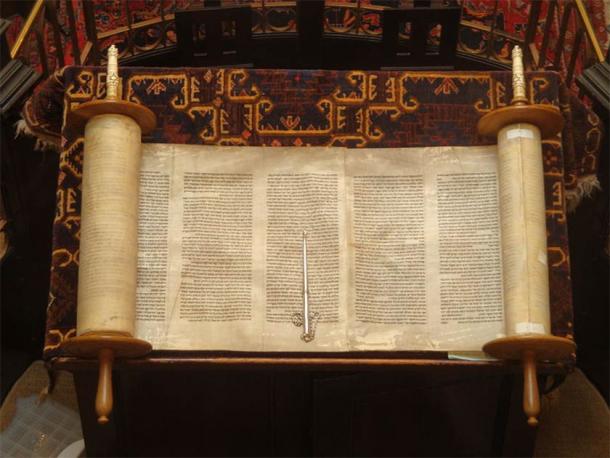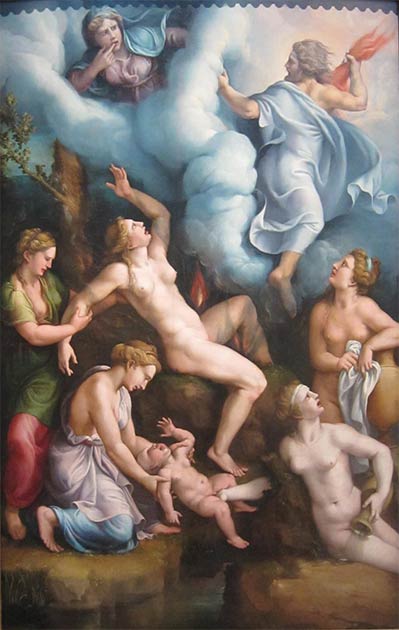For anyone familiar with the Bible, the story of the Israelite god Yahweh is a simple one. Yahweh appears to Abraham in the book of Genesis and enters into a covenantal alliance with him. Abraham’s deity, however, is quite distinct from the other gods of Canaan.
He is an invisible god not to be associated with any visual form or image. This aspect of Yahweh is highlighted later in the biblical narrative when the deity presents Moses and the children of Israel with his law or torah. The second commandment of this law code states: lo’ ta’aseh-leka pesel wekol-temunah “You shall not make for yourself a graven idol or any image” (Exodus 20:4).

The Torah, the Jewish Holy Book. (Lawrie Cate/ CC BY 2.0 )
When we turn away from the “orthodox” view of Yahweh presented in the Old Testament as a deity completely separate and distinct not only from the gods of Canaan but, as Second Isaiah would argue, any other god worshipped throughout the world, we see that Yahweh’s relation to non-Israelite deities and religions is not nearly as black and white as the biblical authors make it seem. On the contrary, archaeology as well as ancient written sources suggest far greater congruence between Yahweh and these other deities. This article examines one example of such congruence as seen in the parallels between the biblical Yahweh and the Greek god Dionysus (Latin: Bacchus).
Parallels between Yahweh and Dionysus
This article contributes to the field of ancient studies in several ways. First, it specifically examines the theological parallels between Yahweh and Dionysus. We know from the archaeological record that Yahweh was in fact worshipped as Dionysus in the later classical era, but most studies of this phenomenon, such as the work of Nissim Amzallag, have focused on specific archaeological sites and epigraphic evidence.

We know from the archaeological record that Yahweh was in fact worshipped as Dionysus in the later classical era. ( morane /Adobe Stock)
Secondly, the classical and biblical worlds are often viewed as two completely separate and distinct spheres. This segregation persists in modern academic circles with theological/biblical studies existing as a completely separate discipline from “classical” studies, despite significant overlap between the two. This article serves to deliberately bridge that gap and show that these worlds…or these two gods…were not as different as we have traditionally made them out to be.
Who was Dionysus?
In discussing who Dionysus was, it is best to begin by talking about who he was not. Though one of the most popular deities of the Greco-Roman pantheon, Dionysus was not originally a Greek god. This is attested to within the tradition itself, where Dionysus is not included among the twelve Olympian gods – which suggests that he is a late addition to the assembly.
His birth story also suggests that he was unceremoniously grafted into the Greek mythological tradition. According to this story, Dionysus’ mother was accidentally killed by Zeus when she was pregnant. In remorse, Zeus took the fetus and put it into his thigh for the remainder of the incubation period. Hence, the etymology of the deity’s name, which literally means the “twice-born” god.

‘The Birth of Bacchus’, by Giulio Pippi, called Giulio Romano. ( CC0)
In regard to his place of origin, many scholars have suggested that he was originally an east Asian deity who became popular among the Greeks and Romans. His birth story reflects this religious appropriation. Later stories highlight Dionysus’ peculiarities among the Greek gods.
As the god of wine and revelry, he roams the forest engaging in various acts of sensual pleasure with his nymphs and satyrs. At first glance, one could argue that Dionysus is the exact opposite of the morally strict Israelite deity Yahweh. As we will see, however, these two deities had far more in common than one might think.

Phoenician drachm, 4th century BC, on exhibit in the British Museum. The coin shows a seated deity, labelled either “YHW” (Yahu) or “YHD” (Judea). ( Public Domain )
Yahweh Dionysus?
One of the most interesting theological parallels between the biblical god Yahweh and Dionysus is also the most scandalous. Both deities had a ‘ sex cult ’, a very similar sex cult, devoted to them. This is less surprising for Dionysus, where the mythological tradition and religious rites make this quite explicit.
On the other hand, the notion of the Old Testament god having such a cult is at first glance astounding. Nevertheless, evidence for it is found in the Bible if one is willing to look past the “orthodox” depiction of Yahweh presented by the biblical authors to examine the various counter-narratives of the Old Testament.
This link between sex and religious ecstasy, so common in Dionysian lore and practice is seen very early in the Old Testament depiction of Yahweh in the account of Israel’s apostasy in Exodus 32. In this story, Israel’s leader – the lawgiver Moses – delays coming down from the mountain of God, leading the people to erect a golden calf and engage in revelry. The sexual nature of this act is made explicit in the Hebrew term arum used in Exod. 32:25 which reads: “and Aaron had made them get naked to embarrass themselves before their enemies.”

‘Adoration of the Golden Calf’ by Antonio Molinari. ( Public Domain )
In popular culture, the story is often read dualistically as a contest between religious piety and pagan sexual excess. On one side are Moses and his loyalists and on the other the Israelite people in general. However, it is more accurate to see these two things not as polar opposites but as one. In other words, sexual excess in the service of/for the purpose of religious piety. As the biblical text states, the Israelites hold a festival (Hebrew: hg) in which they engage in orgiastic praise of Yahweh personified in the golden calf.
This brings us to a second connection between Dionysus and Yahweh, namely that both deities were associated with the bull . In Dionysian religion this is seen in the depiction of the deity with bull-like horns. As noted earlier, even though the “orthodox” religion of the biblical authors precluded any anthropomorphic images of the Hebrew God, Israelite religion frequently identified Yahweh with the bull. This stems in part from the fact that Israelite religion had its origins in Canaanite religion, where the high god El – who later merges with the biblical god – is associated with the bull.

El, the Canaanite creator deity, Megiddo, Stratum VII, Late Bronze II, 1400-1200 BC, bronze with gold leaf – Oriental Institute Museum, University of Chicago. ( CC0)
The biblical god and the bull has been largely muffled by English translations of the Old Testament. In various stories where Yahweh inflicts wrath on the Israelites for their disobedience, the King James Version and more modern New International Version simply read “the Lord became angry.” However, the actual Hebrew is most literally translated as “Yahweh’s nose turned red” – an allusion to the smoke that comes from a bull’s nose when agitated.
Moreover, both the Old Testament god and the Greek Dionysus were identified as wilderness deities. As legendary classicist Edith Hamilton noted, Dionysus’ followers “went to the wilderness to worship , the wildest mountains, the deepest forests, as if they kept to the customs of an ancient time before men had thought of building houses for the gods….there Dionysus gave them food and drink.” Rogar Lancelyn Green provides a similar portrait of Dionysian religion, stating that “many women, who were called Maenads, followed Dionysus, and these often deserted their husbands and children to go dancing away on the lonely hillsides.”

‘La jeunesse de Bacchus’ (The Youth of Bacchus) by William-Adolphe Bouguereau. ( CC BY 2.0 )
In like manner, Yahweh is frequently associated with the wilderness throughout the Old Testament narrative. Moses himself first encounters Yahweh on the holy mount located in the wilderness of Midan (Exod. 3). Later, when the Israelites are freed from servitude in Egypt they wander the desert for 40 years led in their travels by the wilderness god Yahweh.
A direct association between Yahweh and the wild, deserted regions is found in the book of Job, when the deity claims closer affinity to the creatures of the desert than with “civilized” urban society (Job 40-42). This association is also made by the prophet Isaiah, who writes:
Qol qore’-bamidbar
Pannu derek yhwh
Yasru ba’arabah mesillah le’lohenu
The voice of one crying in the wildness
Turn to the way of Yahweh
Make in the desert a road for our god (Isaiah 40:3)
One final parallel between Yahweh and Dionysus can be found in the beverage associated with each deity. One of the most famous and well-known aspects of Dionysus and the Dionysian cult in Western culture is the god’s association with the fruit of the wine. In frescoes and mosaics Dionysus is frequently presented as wearing or holding a cluster of grapes by means of which he makes the wine that brings about the sexual fervor of his followers.

In frescoes and mosaics Dionysus is frequently presented as wearing or holding a cluster of grapes. ( migfoto /Adobe Stock)
This association is highlighted in the story of Dionysus’ capture by pirates. As Lancelyn Green describes this tale, when the pirate ship took Dionysus on board “grapes grew in great, dark bunches down either side of the sails, and the thole-pins between which the long oars rested grew up into vines clustered with flowers.”
Ironically, while the Judeo-Christian tradition (having its origins in the ancient worship of Yahweh) tends to frown upon the consumption and use of alcohol, the biblical witness attests to the use of wine in Israelite religion as a sacred beverage similar to what one finds in the cult of Dionysus.
The association of Yahweh with the vine is found in the earliest sources of the Old Testament. For example, in the story of Abraham’s encounter with Melchizedek, king of Salem, it is said that the king hosi lehem wayayin “brought out bread and wine” (Genesis 14:18). Elsewhere, drink (i.e. wine) offerings are presented to the deity on numerous occasions (Lev. 23:18; Num. 15:5; Deut. 12:17). In Christianity, this link between the deity and wine is continued in the Eucharistic rite in which the wine literally represents the presence of the deity.

In Christianity, this link between the deity and wine is continued in the Eucharistic rite in which the wine literally represents the presence of the deity. ( Public Domain )
Strong Points of Congruence
The late Joseph Campbell, one of the most renowned scholars on comparative religion, often argued for an “imminent frame” which explained the commonalities between the various gods who have risen and fallen in the course of human history and society. The strong points of congruence between Dionysian and Israelite religion provide a notable example of this phenomenon, one which continues to have profound lessons for us today in an age of increased religious polarization.
Top Image: There are theological parallels between Yahweh and Dionysus. Source: fluenta /Adobe Stock
References
N. Amzallag, “Were YHWH and Dionysus once the same God?” Friends of Asor 5 (2017). http://www.asor.org/anetoday/2017/08/yhwh. Accessed online 8 Sept. 2020; “Was YHWH worshipped in the Aegean” JSOT 35 (2011), 387-415.
E. Hamilton, Mythology (Boston, MA.: Brown, Little and Company, 1942), 68.
R. Lancelyn Green, Tales of the Greek Heroes , 79 (New York: Puffin, 1994).
Related posts:
Views: 4
 RSS Feed
RSS Feed

















 September 22nd, 2020
September 22nd, 2020  Awake Goy
Awake Goy  Posted in
Posted in  Tags:
Tags: 
















